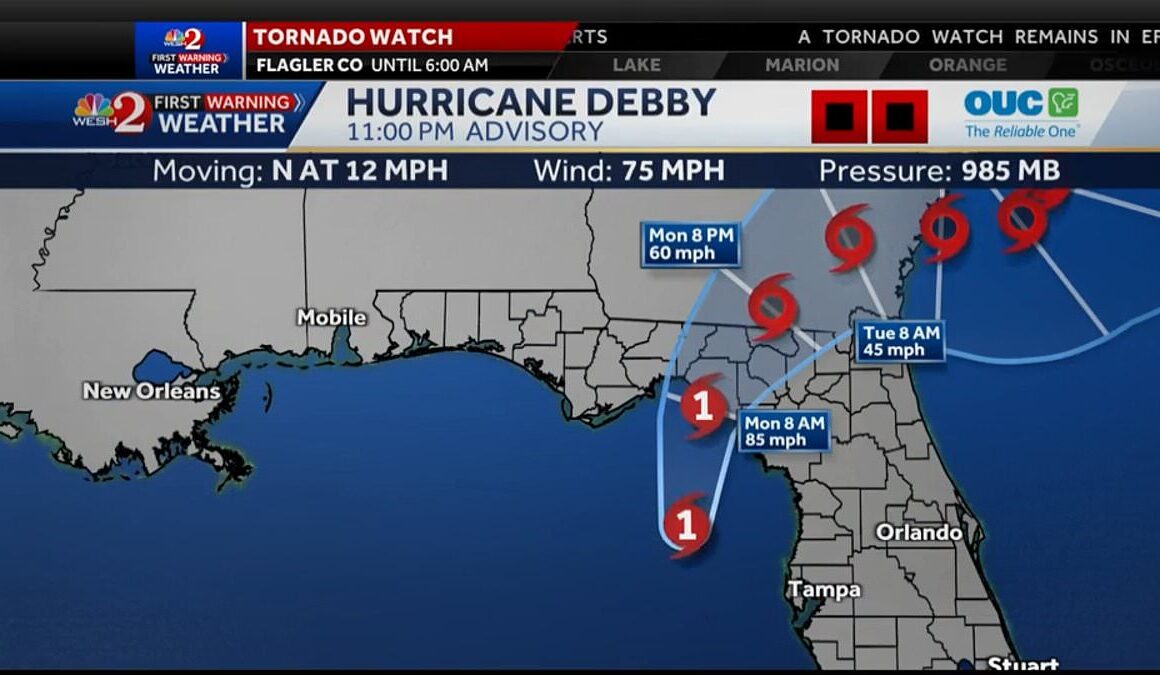Tropical Storm Debby has been upgraded to a Category 1 hurricane by the National Hurricane Center, and it continues on a collision course with the Florida coastline.
The agency issued a storm advisory at 11pm warning that hurricane winds of 75 miles per hour present a ‘major flood threat’ to the southeastern US this week.
A hurricane warning is now in effect for the Florida gulf coast from Yankeetown – 93 miles north of Tampa – all the way to Indian Pass, which is well into the Florida panhandle.
Hurricane Debby is likely to threaten multiple areas of Florida with flooding, but the exact timing of rainfall is still undetermined.
The hurricane will make landfall by Monday at 8am in the Big Bend of Florida, an region of marshland and woodlands that also contains Tallahassee, a city of over 200,000.

Pictured: Most recent radar images of Hurricane Debby, showing the storm directly over the eastern portion of the Gulf of Mexico, though cities as far as Jacksonville and Orlando are already within the crosshairs

Before it was a hurricane, Debby brought at least two feet of storm surge to southwest cities like Fort Myers, with photos showing cars there completely underwater
Gainesville and Jacksonville are also likely be under major threat as the hurricane progresses.
‘Debby is then expected to move slowly across northern Florida and southern Georgia Monday and Tuesday, and be near the Georgia coast by Tuesday night,’ according to the advisory.
By the middle of the week, the hurricane is expected to dump nearly two feet of rain on parts of Georgia and South Carolina.
Specifically, the cities of Savannah, Georgia, and Charleston, South Carolina could both be hit with a month’s worth of rain in a single day – and maybe even a typical summer’s worth of rain throughout the course of the storm, ABC7 reported.
This ‘ potentially historic rainfall‘ across southeast Georgia and South Carolina, as the National Hurricane Center put it, will cause dangerous flash flooding.

This graphic shows the coastlines in Florida, as well as Georgia and South Carolina that will be most affected by storm surges as Hurricane Debby takes its path

Mabrey Shaffmaster, left, carries her nephew, Arlo Hoggard, 3, left, as her sister, Morgan Hoggard, carries nine-month-old son Ace Hoggard through a flooded street as Tropical Storm Debby approaches Florida on on Sunday, August 4, 2024 in Tarpon Springs, Florida
In response, the governors of Florida, Georgia and South Carolina have already declared a state of emergency and are urging residents to hunker down and prepare for the multiple impacts of the storm.
‘I think what’s going to make this much different than what we had with Idalia is it is going to move very slowly once it enters Florida – it’s going to be southern Georgia, northern Florida – and it is just going to drop an inordinate amount of water on the north central Florida region,’ Florida Gov. Ron DeSantis told FOX Weather on Sunday.
‘There’s going to be a lot of trees that are going to fall down. You’re going to have debris. You are going to have power interruption,’ he added, ‘so just prepare for that.’
Right now, the center of the hurricane is situated in the eastern Gulf of Mexico, with the outer parts of the storm lashing the west coast of the Florida peninsula.
A preview of what’s to come was seen along beach cities like Fort Myers, Sanibel Island, and Gulf Port, which are all set along the state’s famously volatile western coast.
Fort Myers was hit hard with intense flooding, though no official evacuation order was given.

St. Petersburg Stormwater Management workers Mariano Morales, left, and Brad Sharp, work to clear debris from a flooded street in Shore Acres during Tropical Storm Debby

Workers place plywood over the windows of a business as they prepare for the possible arrival of Debby in Cedar Key, Florida
Cape Coral also experienced flooding, as did the sister cities’ barrier island Sanibel, and Gulf Port further north.
In St. Petersburg, which is near Tampa, waves bashed the coast as tropical storm-force winds howled.
Thousands of Tampa Bay area residents remain without power, even though the storm is gradually leaving the area.
There are a total of more than 80,000 customers who have no electricity in Florida as of 1am ET, according to poweroutage.us.
The hurricane advisory stressed that the incoming storm is ‘a life-threatening situation,’ and people within the affected or soon-to-be-affected areas should take precautions to protect themselves and their property from rising water levels.
When the hurricane eventually makes landfall, WeatherTiger meteorologist Ryan Truchelut said he expects Tallahassee to escape the worst of the storm’s vengeance.
He expects Tallahassee will see sporadic lower end tropical storm winds ranging from 40 to 50 miles per hour, he told the Tallahassee Democrat.

Floodwaters cover parts of the Shore Acres neighborhood of St. Petersburg

A bread aisle is almost bare in a Walmart store in Cedar Key as people stock up to weather the storm
Forecasters are taking to social media to explain how Debby’s landfall is yet another sign that this year’s hurricane season could be nightmarish.
Colorado State University hurricane research Philip Klotzbach noted that Hurricane Beryl just recently made landfall in Texas in July.
‘It would be only the 9th year on record with two continental US hurricane landfalls by August 5,’ he wrote on X. ‘Other years were: 1886, 1909, 1916, 1934, 1936, 1959, 2005, and 2020. Hurricane Beryl made landfall in Texas in July.’
A tornado watch has also been issued for much of the Florida Peninsula and parts of southern Georgia until Monday morning, covering more than 13 million people, including the cities of Tallahassee, Jacksonville, Tampa and Orlando.
State courts in 22 counties will be closed in anticipation of the storm’s arrival, according to a social media post from the Florida Supreme Court.

This National Oceanic and Atmospheric Administration satellite image taken at 11:11pm ET on Sunday shows Hurricane Debby approaching Florida

A Jeep drives through a flooded street early on Sunday, before Debby would strengthen into a hurricane
Debby is also wreaking havoc at airports as far down the coast as Miami.
Miami International Airport has seen 265 cancellations and more than 300 delays for both outgoing and incoming flights, according to FlightAware.
Likewise, the airports serving Fort Lauderdale, Orlando and Tampa have seen dozens of cancellations and hundreds of delays.
Tallahassee Mayor John Dailey announced on X that the city’s airport would be preemptively shutting down at midnight.
‘Tallahassee International Airport will suspend non-emergency operations beginning at midnight and anticipates resuming normal operations at noon Monday,’ Dailey wrote.
‘The Fire Department has five units equipped with rescue watercraft available for immediate deployment should water rescues and/or evacuations be necessary.’

Waves battered the Tampa Bay area throughout the day on Sunday

Palm trees on the Fort Myers coast are blown in the wind as Debby tears up Florida
As Debby inevitably moves inland, President Joe Biden approved a disaster declaration for Florida on Sunday, which will send federal resources and personnel to deal with relief efforts.
It isn’t yet clear if Biden will do the same for Georgia and South Carolina, both soon-to-be targets of the impending system.
The next hurricane advisory from the National Hurricane Center will be published at 2am ET.








